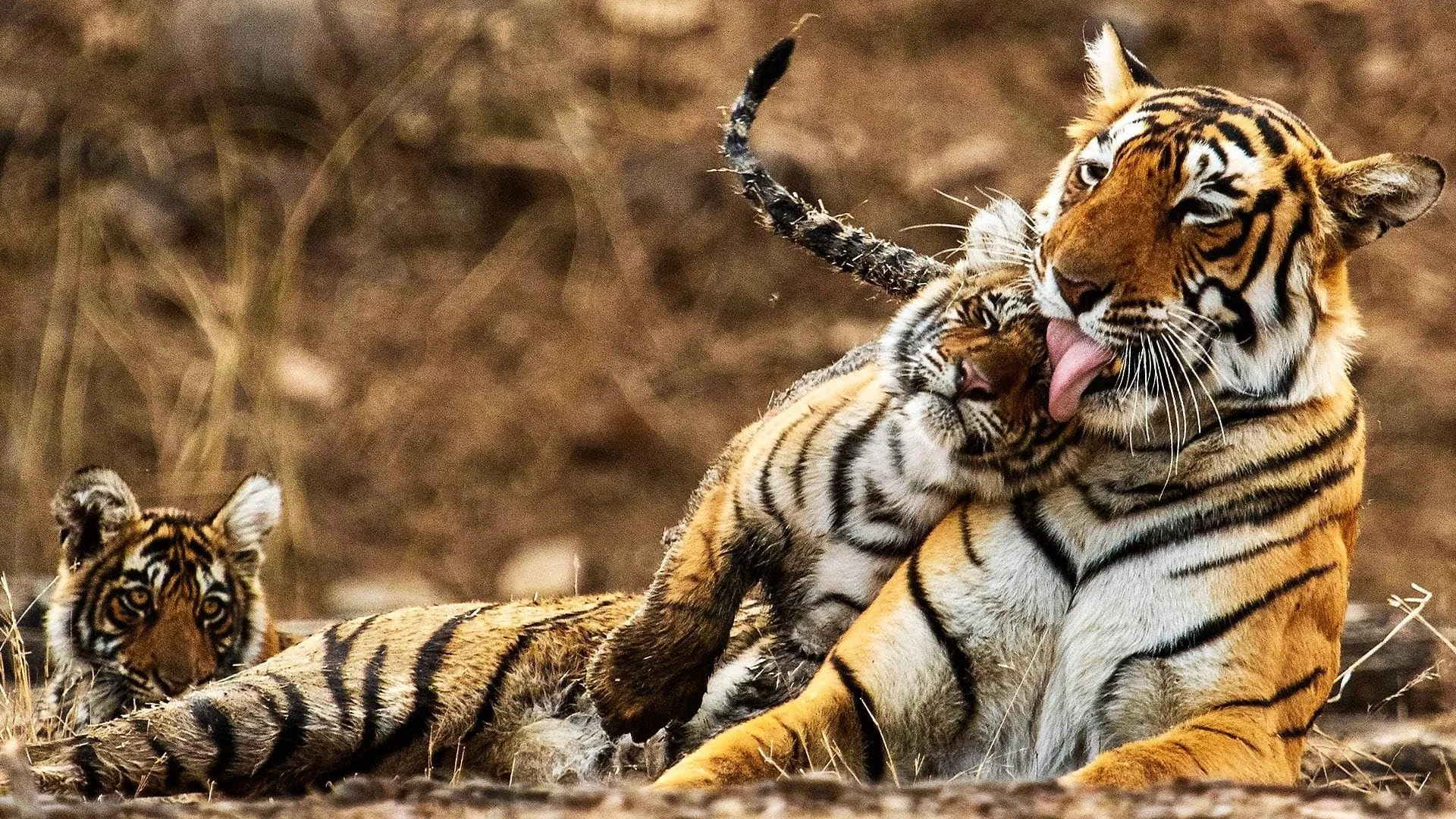Set amidst the stunning wilderness of northern India, My Tiger Family offers viewers a doorway into the magical realm of Ranthambore Nature Reserve. For over 50 years, filmmaker Valmik Thapar has observed the resident tiger population with steadfast dedication, establishing profound connections with these elusive queens of the forest. The documentary shares Thapar’s intimate journey, introducing us to several generations of strong-willed tigresses who call Ranthambore home.
Thapar’s initial encounter with the reserve’s tigers sparked a lifelong passion. As a young man visiting on a whim, he wandered the forest trails and glimpsed his first tiger—an experience he describes as profound self-reflection.
Rather than departing, he remained to immerse himself in understanding these majestic creatures. Over decades, Thapar acquired unprecedented insights by quietly observing tigers like Padmini raise their cubs. He witnessed the population rebound from grim lows yet also faced setbacks as poachers threatened the recovery.
The film draws from Thapar’s vast archive of encounters. Through his lens, we tag alongside matriarchs like Noon as they compete and cooperate to sustain their dynasty. His deep concern for the tigers’ welfare shines through, as does nostalgia for “the best days” spent in their company.
My Tiger Family grants viewers rare glimpses into the intimate dynamics of Ranthambore’s tiger society. But beyond capturing enthralling animal behaviors, it celebrates Thapar’s lifelong labor of advocacy that helped pull India’s tigers back from the brink of extinction.
The Queens of Ranthambore
For over fifty years, one man bore witness to the lives of Ranthambore’s ruling tigers. Through Valmik Thapar’s dedicated observations, several generations of these fierce yet fascinating females were given a human face. Chief among them were the indomitable Padmini and her matrilineal descendants—Noon, Machli, and others—whose stories occupy the heart of My Tiger Family.
Padmini survived the era of mass hunting, raising her cubs in what must have felt like a constantly dangerous time. But the reserve eventually became safer under conservation efforts. We see her pass the torch to Noon, who embodied the new generation exploring Ranthambore freely. Noon especially stood out thanks to her fondness for midday hunting—an idiosyncrasy that was perfectly reflected in her name.
What comes across so clearly is Thapar’s deep affection for these individual tigers. We see footage of Noon and her mate Genghis playing together that was surely filmed with loving eyes. When tragedies struck, like the poaching crisis where two-thirds of tigers were lost, Thapar’s sorrow was palpable. Yet some pillars of the community endured, like resilient Machli, who went on to leave her legendary DNA across Ranthambore.
More than any encyclopedia, this film offers an intimate glimpse into the everyday dramas, family ties, and quirks of tiger life that so enthralled its chronicler. Thapar vividly brings these queens of the jungle to life, a fitting tribute to the special bond built over a lifetime among Ranthambore’s magical tigers.
Tiger Trials at Ranthambore
To understand My Tiger Family, one must comprehend the challenges faced by Ranthambore’s tigers over generations. Originally numbering over 100,000 across India, tiger populations faced drastic decline due to hunting by wealthy colonizers and locals. One ruling maharajah even claimed a shocking personal tally of over 1,300 tigers shot. By the early 1970s, a mere 1,800 wild tigers remained nationwide when conservation efforts began under Project Tiger.
Into this context came young Valmik Thapar, greeted at Ranthambore by just a dozen surviving tigers living in constant fear. Through observation and advocacy, he played a role as their numbers gradually doubled to 45 under new protections. A golden period ensued as this generation explored freely without past dangers. But crises soon struck from an unexpected threat—poachers supplying black markets with tiger parts. Tragically, two-thirds of Ranthambore’s tigers were annihilated by heavily armed poachers.
Over five decades, Thapar persevered as an influential activist. He advised government committees on successful strategies while raising global awareness through books, films, and his wildlife charity. Though twice more was Ranthambore’s population decimated by surges in poaching, coordinated conservation under the National Tiger Authority eventually prevailed through challenges.
Thapar’s lesser-known contributions were as vital as his camera work in restoring tigers to the lush forests where Rudyard Kipling once found inspiration. A truly epic battle between man and nature, yet offering hope where courage and compassion combined.
Rare Glimpses of the Tiger World
While centered on personal relationships, My Tiger Family also unveiled unseen facets of tiger natural history. Through over 50 years of patient filming, Valmik Thapar captured behavior seldom documented before.
His iconic shots, like a tiger dragging down a deer in deep water, redefined our picture of their hunting abilities. We also witness an unheard of interaction—a mother nursing fully grown cubs, hinting at complex social bonds.
Elsewhere, footage shows a striking exchange between tigers and crocodiles, with both predators seemingly at ease in each other’s domain. Most astonishing is a fiery female overpowering a colossal 20-foot croc, displaying ferocious strength even against such a giant reptile. Thapar also records solitary predators subduing massive aquatic turtle prey, expanding our view of their versatile skills.
Beyond dazzling images, Thapar’s collection imparted new factual insight. Notions of tigers as solely nocturnal were shattered by day-roaming matriarchs raising their families in forest clearings. These profound glimpses into behavior rarely seen in nature reserves enrich our understanding, even if individual tigers remain the documentary’s foremost focus. Thapar’s lifelong vigil at Ranthambore has illuminated seldom witnessed facets of the secret tiger world for scientists and cinema fans alike to marvel at.
The Camera’s Intimate Gaze
For over half a century, filmmaker Valmik Thapar quietly captured the private world of Ranthambore’s tigers with artistry and passion. The verdant jungles and ruins portrayed in My Tiger Family draw viewers deep into this storybook domain. Likewise, depictions of mighty hunts leave viewers in awe of the big cats’ raw power and predatory mastery.
However, it’s the intimate close-ups afforded by Thapar’s gifted camerawork that make one feel they’re glimpsing these elusive predators in an almost domestic setting. Subtle twitches and gleams in their eyes expose profound individual traits. Their uncannily humanesque expressions seem to convey intricate emotions and thoughts lying just beneath the surface.
Co-director Mike Birkhead played a pivotal supporting role, but this was assuredly Thapar’s vision, fueled by a half-century bonding with his favorite subjects. Together, their skilled cinematography and direction transported audiences to Ranthambore’s shores and heart of the jungle to witness unobstructed moments seldom seen.
Through sensitive portrayal of the tigers as spectacular yet sympathetic wild neighbors, My Tiger Family stands as a monument to the natural treasures that can be unveiled by one gifted observer’s longstanding artistic exploration and conservationist drive.
Life Lessons from the Tigers
On the surface, My Tiger Family offers glimpses into the lives of Ranthambore’s queens. Yet deeper messages reverberate throughout regarding mankind’s relationship with the natural world. The film tells a poignant story about humanity’s capacity for both destruction and stewardship.
In ages past, shortsighted consumption decimated India’s original vast tiger population through hunting for trophies and profit. Only through visionaries like Thapar did attitudes change to value these marvels living amongst us. His documentation played a part in the growing global desire to aid conservation that pulled tigers back from the brink.
But threats remain, as illustrated by poaching resurgences endangering recovery. The film serves as a reminder that wildlife protection demands constant vigilance. Through artistic portraits of these sentient survivors, it pleads for protecting the intricate biodiversity that enriches all life on Earth.
Most of all, My Tiger Family celebrates figures like Thapar who dedicate themselves to understanding nature rather than exploiting it. By his lifelong labor illuminating tigers’ rich inner worlds, a lesson shines through: when curiosity replaces cruelty, both humans and wildlife can thrive as peaceful neighbors within the forest realm we all call home.
A Lifetime Among the Tigers
Over its runtime, My Tiger Family has transported viewers on a journey through five decades of one man’s life entwined with the big cats he came to revere. We’ve given witness to Valmik Thapar’s unparalleled observations, offering new perspectives on tiger behaviors, social bonds, and mysteries. Through his lens we’ve formed strong attachments to the regal matriarchs ruling Ranthambore’s jungles.
Thapar’s relentless dedication to conservation has been evident through crises faced by the tigers he loves. Despite threats, their numbers have risen through his efforts in raising awareness and shaping policy. This film stands as a testament to the impact an individual can make through compassion alone.
While focusing on cherished individuals, the documentary tells a far greater tale. It reminds us why safeguarding biodiversity and our wild neighbors matters deeply. As climate change brings new dangers, Thapar’s example shows maintaining vigilance remains crucial to our shared future.
For anyone passionate about wildlife or the magic of cinema, My Tiger Family offers an intimate look into an endangered world too often kept distant. It celebrates a lifelong artistic and ecological partnership that created deeper understanding and helped revive India’s iconic tigers. Their story isn’t over, and neither is Thapar’s role as a natural guide leading us into the hidden heart of the tiger kingdom.
The Review
My Tiger Family
In intimate yet epic scope, My Tiger Family presents a profound tribute to individual wild lives and the human effort of protecting natural wonders. Filmmaker Valmik Thapar brings viewers into the secret worlds of Ranthambore's tiger queens through an artistic lens honed across intimate decades among them. Both heartwarming and sobering, this documentary stands as an essential tale of continuity amid change, observing a shared destiny between man and nature's most magnificent predators.
PROS
- Intimate, long-term perspectives of individual tiger lives and personalities
- Glimpses of rare behaviors that enhance scientific understanding
- Beautiful cinematography that vividly portrays the forest realm
- Inspiring conservation message and appreciation of biodiversity
- Celebrates Thapar's crucial advocacy that reversed tigers' decline
CONS
- Lacks context on Thapar's full career impact beyond Ranthambore
- Minimal examination of political/policy dimensions of conservation
- Mostly overlooks cultural/historical context of human-tiger relations



















































